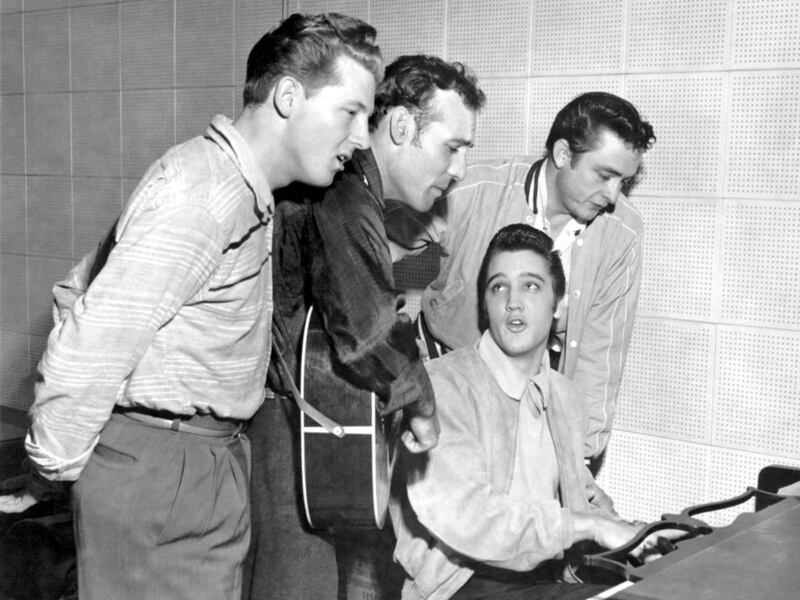This week, Prophets of Rage cemented their status as the angriest supergroup of all time by unleashing their self-titled debut single.
Prophets of Rage is a cover of a 1988 track by Public Enemy, two members of which feature in the new crew, along with three musicians from the similarly shouty Rage Against the Machine. B-Real from Cypress Hill, the sixth member of the group, is presumably there just to calm things down a little.
Such a furious rap-rock gathering might seem radical, but the truth is that the history of supergroups is more diverse than you might think, with roots dating way back beyond 1960s rock, where the term originated.
All-star collaborations rarely shine brightly for long, though, whatever the era or genre.
Even Mozart’s mighty collective received lukewarm reviews. In the late 1700s, four eminent composers met for regular string jams: Haydn and Dittersdorf (on violins), Mozart (viola) and Vanhal (cello). Their combination proved anticlimactic for some.
“The players were tolerable,” said tenor Michael Kelly, of one performance. “Not one of them excelled on the instrument he played”.
But what exactly qualifies as a supergroup in modern music? According to Guitar World magazine, it should contain at least three already-famous members, and must release an album.
A notable example is the fabled, but fleeting, Million Dollar Quartet. Made up of rock icons Elvis Presley, Johnny Cash, Jerry Lee Lewis and Carl Perkins, they had yet to achieve full global fame individually when they convened at Sun Studios in Memphis in December 1956, which perhaps explains why the tapes were mislaid. The recordings were eventually released in 1981, after which the surviving members reformed for a live album.
Generally, the word “supergroup” suggests bands from the late 1960s or early 1970s, when the egos were as epic as the riffs.
Experimental trio Emerson, Lake and Palmer were individually famous enough to use only their surnames – see also Crosby, Stills, Nash and Young – which would seem pompous now.
But then, what is arguably the world’s finest supergroup were also hardly bashful. Cream originally started out as The Cream, because Eric Clapton, Ginger Baker and Jack Bruce were widely regarded as the cream of their generation of musicians.
The band only survived for two years but proved massively influential. Their uniquely visceral rock sound largely stemmed from Bruce and Baker’s mutual loathing, proving that band chemistry doesn’t have to be purely musical – or good.
Baker was also an acclaimed jazz drummer, a genre in which practically every classic recording involves a supergroup: Miles Davis's Kind of Blue, for example, features Bill Evans, John Coltrane and Cannonball Adderley.
Contrast that with pop, where stars struggle to get along with each other long enough to record just one song. Thrown together for Lady Marmalade, from the Moulin Rouge movie soundtrack, in 2001 (with Mya and Lil Kim), Pink and Christina Aguilera's people were arguing before they even entered the studio.
Male divas have difficulties, too. The Three Tenors were opera’s own supergroup between 1990 and 2003, selling more than 10 million copies of their debut concert album.
Behind the scenes, however, Carreras and Domingo complained that Pavarotti was secretly acquiring extra royalties. Meanwhile, critics castigated the trio for putting easy money before their art.
Selling millions of records is a rarity nowadays, and modern supergroups tend to be outlets for more challenging work.
To get away from the celebratory Britpop sounds of Blur, frontman Damon Albarn formed the brooding The Good, The Bad and The Queen with Clash bassist Paul Simonon and Verve guitarist Simon Tong, plus the legendary Afrobeat drummer Tony Allen.
The latter also appeared in Rocketjuice and the Moon with Albarn and Red Hot Chili Peppers’ bassist Flea, who in turn also appeared in Atoms for Peace with Radiohead frontman Thom Yorke, and the band’s producer Nigel Godrich.
Like most supergroups, this trio of bands only released one album each, to varying degrees of success.
Which brings us to the last point about supergroups – and a worrying sign for fans of The Prophets of Rage: they don’t last long. In most cases, they are examples of the adage “the brightest stars burn quickest” – so enjoy them while you can.
artslife@thenational.ae





